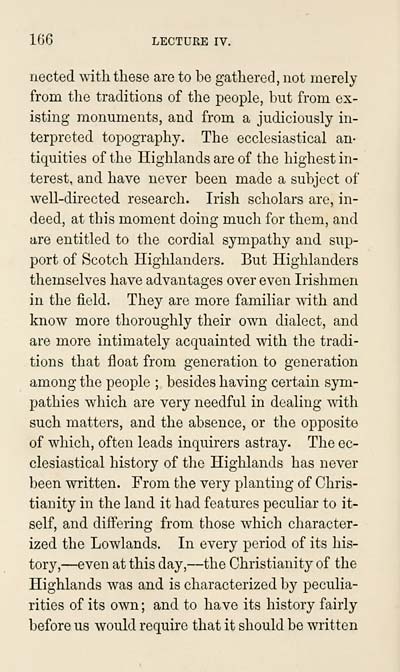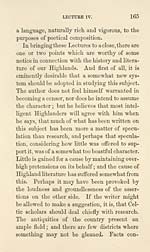Blair Collection > Celtic gleanings, or, Notices of the history and literature of the Scottish Gael
(178)
Download files
Complete book:
Individual page:
Thumbnail gallery: Grid view | List view

166 LECTURE IV.
riected with these are to be gathered, not merely
from the traditions of the people, but from ex-
isting monuments, and from a judiciously in-
terpreted topography. The ecclesiastical an-
tiquities of the Highlands are of the highest in-
terest, and have never been made a subject of
well-directed research. Irish scholars are, in-
deed, at this moment doing much for them, and
are entitled to the cordial sympathy and sup-
port of Scotch Highlanders. But Highlanders
themselves have advantages over even Irishmen
in the field. They are more familiar with and
know more thoroughly their own dialect, and
are more intimately acquainted with the tradi-
tions that float from generation to generation
among the people ; besides having certain sym-
pathies which are very needful in dealing with
such matters, and the absence, or the opposite
of which, often leads inquirers astray. The ec-
clesiastical history of the Highlands has never
been written. From the very planting of Chris-
tianity in the land it had features peculiar to it-
self, and differing from those which character-
ized the Lowlands. In every period of its his-
tory, — even at this day, — the Christianity of the
Highlands was and is characterized by peculia-
rities of its own ; and to have its history fairly
before us would require that it should be written
riected with these are to be gathered, not merely
from the traditions of the people, but from ex-
isting monuments, and from a judiciously in-
terpreted topography. The ecclesiastical an-
tiquities of the Highlands are of the highest in-
terest, and have never been made a subject of
well-directed research. Irish scholars are, in-
deed, at this moment doing much for them, and
are entitled to the cordial sympathy and sup-
port of Scotch Highlanders. But Highlanders
themselves have advantages over even Irishmen
in the field. They are more familiar with and
know more thoroughly their own dialect, and
are more intimately acquainted with the tradi-
tions that float from generation to generation
among the people ; besides having certain sym-
pathies which are very needful in dealing with
such matters, and the absence, or the opposite
of which, often leads inquirers astray. The ec-
clesiastical history of the Highlands has never
been written. From the very planting of Chris-
tianity in the land it had features peculiar to it-
self, and differing from those which character-
ized the Lowlands. In every period of its his-
tory, — even at this day, — the Christianity of the
Highlands was and is characterized by peculia-
rities of its own ; and to have its history fairly
before us would require that it should be written
Set display mode to: Large image | Transcription
Images and transcriptions on this page, including medium image downloads, may be used under the Creative Commons Attribution 4.0 International Licence unless otherwise stated. ![]()
| Early Gaelic Book Collections > Blair Collection > Celtic gleanings, or, Notices of the history and literature of the Scottish Gael > (178) |
|---|
| Permanent URL | https://digital.nls.uk/76270702 |
|---|
| Description | A selection of books from a collection of more than 500 titles, mostly on religious and literary topics. Also includes some material dealing with other Celtic languages and societies. Collection created towards the end of the 19th century by Lady Evelyn Stewart Murray. |
|---|
| Description | Selected items from five 'Special and Named Printed Collections'. Includes books in Gaelic and other Celtic languages, works about the Gaels, their languages, literature, culture and history. |
|---|

